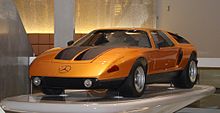|
Mercedes-Benz C111
    The Mercedes-Benz C111 was a series of experimental automobiles produced by Daimler-Benz in the 1960s and 1970s. The company was experimenting with new engine technologies, including Wankel engines, diesel engines, and turbochargers, and used the basic C111 platform as a testbed. Other experimental features included multi-link rear suspension, gull-wing doors and a luxurious interior with leather trim and air conditioning. HistoryThe first version of the C111 was completed in 1969, and presented at the 1969 IAA in Frankfurt. The car used a fiberglass body shell and with a mid-mounted three-rotor direct fuel injected Wankel engine (code named M950F). The next C111 appeared in 1970; it was shown at the 1970 Geneva International Motor Show. It used a four-rotor engine producing 260 kW (349 hp).[1] The car reportedly could reach a speed of 300 km/h (186 mph).[5] The company decided not to adopt the Wankel engine and turned to diesel experiments for the second and third C111s. The C111-IID's engine was a Mercedes-Benz OM 617, and produced 140 kW (188 hp) at 4200 min−1. It was based on the Mercedes-Benz 85 kW variant of the OM 617 used in the Mercedes-Benz W 116 S-Class, but had a different turbocharger without a wastegate, which allowed an increased pressure ratio of 3.3. Daimler-Benz also added an intercooler that significantly improved the engine's thermal efficiency.[2] The C111 III prototype that was completed in 1978, had a more aerodynamic bodywork that gave it an air drag coefficient of 0.195. It had a modified 3-litre version of the Mercedes-Benz OM 617 five-cylinder Diesel, now producing 170 kW (228 hp), and a BMEP of 1.68 MPa, resulting in a maximum torque of 401 N·m at 3600 min−1. It enabled the C111 III to reach a top speed of 338 km/h (210 mph) at the Nardò Ring in 1978, and also to average a 16 l/100 km fuel consumption at an average speed of 325 km/h.[4] The engine was fitted with an M-type inline injection pump of Bosch's PE series with a maximum injection pressure of 40 MPa.[6] The C111 IV had a 4.5 L twin KKK-turbocharged V8 engine that produced 368 kW (493 hp; 500 PS) at 6000/min.[3] This set another record at the Nardò Ring in 1979, with an average speed of 403.78 km/h (250.958 mph), driven by Hans Liebold.[7] Total production was 16 cars: 13 first and second generation Wankel engined cars, two diesel engined third generation cars used in the Nardò record attempt, and a single V8 engined fourth generation car.[8] Mercedes-Benz introduced the C112 at the Frankfurt Motor Show in 1991 as a proposed production sports car. The car used a mid-mounted 6.0 L V12 engine. After accepting 700 deposits, the company decided not to proceed with production. ReferencesNotes
Bibliography
External links |
||||||||||||||||||||||||||||||||||||||||||||||||
